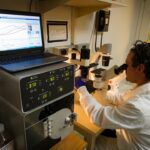Creativity is a complex cognitive process involving the generation of novel ideas, concepts, or solutions to problems. It encompasses the ability to think unconventionally, connect seemingly unrelated concepts, and produce original and unique outcomes. Psychologists have extensively studied the mental processes underlying creativity, identifying several key components.
Divergent thinking, a crucial aspect of creativity, is the capacity to generate multiple ideas or solutions to a problem. This cognitive skill involves breaking free from conventional thought patterns and exploring a wide range of possibilities. Associative thinking, another important element, enables individuals to connect seemingly unrelated concepts or ideas, drawing from diverse knowledge and experiences to produce innovative solutions.
The ability to tolerate ambiguity and uncertainty is also significant in the creative process, as it allows individuals to explore unconventional ideas without fear of failure or criticism. This tolerance facilitates the exploration of new and potentially groundbreaking concepts. Motivation and passion play a vital role in creativity.
Research indicates that individuals who are intrinsically motivated and passionate about their work are more likely to engage in creative thinking and problem-solving. This intrinsic drive helps individuals persist through challenges and setbacks, leading to the exploration of novel ideas and approaches. The psychology of creativity is a multifaceted field of study that provides insights into the mental processes underlying innovative thinking and problem-solving.
By understanding these cognitive mechanisms, researchers and practitioners can develop strategies to enhance creative abilities and foster innovation across various domains.
Key Takeaways
- Creativity involves a combination of cognitive processes, such as divergent thinking and problem-solving, as well as emotional and motivational factors.
- The brain’s ability to generate innovative ideas is linked to the interplay of different regions, including the prefrontal cortex, hippocampus, and cerebellum.
- Environmental factors, such as exposure to diverse stimuli and social interactions, can significantly impact an individual’s creative thinking abilities.
- Emotions play a crucial role in creativity, as positive moods can enhance flexibility and originality in problem-solving, while negative emotions can lead to more focused and detail-oriented thinking.
- Creative problem-solving involves a unique approach to tackling challenges, often characterized by a willingness to take risks, think outside the box, and embrace uncertainty.
Neurological Basis of Creativity: How the Brain Generates Innovative Ideas
Understanding Brain Activity through Neuroimaging
Recent advances in neuroscience have enabled researchers to gain a deeper understanding of how the brain generates innovative ideas. Studies utilizing neuroimaging techniques such as functional magnetic resonance imaging (fMRI) have revealed that creativity involves the coordinated activity of multiple brain regions.
Key Brain Regions Involved in Creativity
One crucial brain region involved in creativity is the prefrontal cortex, which is responsible for higher-order cognitive functions such as problem-solving, decision-making, and creative thinking. The prefrontal cortex plays a vital role in divergent thinking, allowing individuals to generate multiple ideas or solutions to a problem. Additionally, the default mode network, which includes brain regions such as the medial prefrontal cortex and posterior cingulate cortex, has also been implicated in creativity.
The Role of Neurotransmitters in Creativity
Research has shown that the neurotransmitter dopamine plays a key role in creativity. Dopamine is involved in reward processing and motivation, and studies have found that individuals with higher levels of dopamine activity tend to be more creative. This suggests that the brain’s reward system may play a crucial role in driving individuals to engage in creative thinking and problem-solving.
A Complex and Multifaceted Topic
Overall, the neurological basis of creativity is a complex and multifaceted topic that continues to be a focus of research in the field of neuroscience.
Environmental Factors and Creativity: The Influence of Surroundings on Creative Thinking

The environment in which individuals work and live can have a significant impact on their creative thinking and problem-solving abilities. Research has shown that certain environmental factors can either enhance or inhibit creativity, highlighting the importance of creating environments that are conducive to innovative thinking. One important environmental factor that influences creativity is the physical workspace.
Studies have found that open and flexible workspaces that allow for collaboration and interaction among individuals can promote creative thinking. Additionally, natural elements such as sunlight, plants, and views of nature have been found to have a positive impact on creativity, as they can help reduce stress and improve mood, leading to enhanced cognitive functioning. Moreover, social and cultural factors also play a crucial role in shaping creative thinking.
Research has shown that exposure to diverse perspectives and experiences can stimulate creative thinking by broadening individuals’ knowledge and understanding of the world. Additionally, cultural norms and values can influence the way individuals approach problems and generate new ideas. For example, cultures that value individualism and independence may encourage more divergent thinking, while cultures that emphasize conformity and tradition may inhibit creative thinking.
Overall, environmental factors such as physical workspace, natural elements, social interactions, and cultural influences all play a significant role in shaping creative thinking. By understanding how these factors influence creativity, individuals and organizations can create environments that foster innovative thinking and problem-solving.
The Role of Emotions in Creativity: Understanding the Connection between Feelings and Innovation
Emotions play a crucial role in creativity, as they can influence individuals’ cognitive processes and problem-solving abilities. Research has shown that certain emotions can enhance creative thinking by promoting cognitive flexibility, open-mindedness, and risk-taking behavior. One important emotion that has been linked to creativity is positive affect, which includes feelings such as joy, happiness, and excitement.
Studies have found that individuals who experience positive affect are more likely to engage in creative thinking and problem-solving. This is because positive emotions can broaden individuals’ attention and cognition, leading to increased cognitive flexibility and the exploration of new ideas. Conversely, negative emotions such as anxiety and fear can also influence creativity.
While these emotions may initially inhibit creative thinking by narrowing individuals’ focus and attention, they can also serve as a catalyst for innovative ideas. Research has shown that moderate levels of anxiety can lead to increased cognitive processing and attention to detail, which can be beneficial for certain types of creative tasks. Furthermore, the ability to regulate emotions is also important for creativity.
Individuals who are able to effectively manage their emotions are better able to maintain focus and persistence in the face of challenges, leading to enhanced creative thinking and problem-solving abilities. Overall, emotions play a complex and multifaceted role in creativity, influencing individuals’ cognitive processes, problem-solving abilities, and approach to innovation. By understanding the connection between emotions and creativity, individuals can learn to harness their emotions to enhance their creative thinking and problem-solving abilities.
Creative Problem Solving: How the Mind Tackles Challenges in a Unique Way
Creative problem solving is a cognitive process that involves generating innovative solutions to complex or ambiguous problems. Unlike traditional problem-solving methods that rely on logical reasoning and analysis, creative problem solving involves thinking outside the box, making novel connections between ideas, and exploring unconventional approaches. One key aspect of creative problem solving is reframing the problem.
This involves looking at a problem from different perspectives and challenging assumptions about the nature of the problem. By reframing the problem, individuals can uncover new insights and possibilities that may not have been apparent initially. Another important component of creative problem solving is divergent thinking.
This involves generating multiple ideas or solutions to a problem without being constrained by conventional thought patterns or limitations. Divergent thinking allows individuals to explore a wide range of possibilities and consider unconventional approaches to problem solving. Additionally, creative problem solving often involves making connections between seemingly unrelated concepts or ideas.
This type of associative thinking allows individuals to draw on a wide range of knowledge and experiences to come up with innovative solutions. By making novel connections between ideas, individuals can uncover new insights and approaches to problem solving. Overall, creative problem solving is a unique cognitive process that involves reframing problems, divergent thinking, and making novel connections between ideas.
By understanding how the mind tackles challenges in a unique way, individuals can learn to enhance their creative problem-solving abilities and approach complex problems with innovation and ingenuity.
Cultivating Creativity: Strategies for Enhancing and Stimulating Creative Thinking

Encouraging Cognitive Flexibility
One effective strategy for cultivating creativity is engaging in activities that promote cognitive flexibility and open-mindedness. This can include activities such as brainstorming, mind mapping, or free writing, which encourage individuals to explore a wide range of possibilities without being constrained by conventional thought patterns or limitations.
Seeking Out Diverse Experiences and Perspectives
Another important strategy for enhancing creativity is seeking out diverse experiences and perspectives. Exposure to new ideas, cultures, and ways of thinking can stimulate creative thinking by broadening individuals’ knowledge and understanding of the world. This can include activities such as traveling, attending cultural events, or engaging with people from different backgrounds.
Creating a Conducive Environment and Practicing Mindfulness
Moreover, creating an environment that is conducive to creativity is crucial for cultivating innovative thinking. This can involve designing workspaces that promote collaboration and interaction among individuals, incorporating natural elements such as sunlight and plants into the environment, or fostering a culture that values open-mindedness and exploration. Additionally, practicing mindfulness and self-reflection can also help cultivate creativity by promoting emotional regulation and cognitive flexibility.
The Future of Creativity: Advancements in Science and Technology and Their Impact on Innovation
The future of creativity holds exciting possibilities as advancements in science and technology continue to shape the way we approach innovation. From artificial intelligence to virtual reality, these advancements have the potential to revolutionize the way we think about creativity and problem solving. One area where advancements in science and technology are impacting creativity is artificial intelligence (AI).
AI has the potential to augment human creativity by assisting with tasks such as idea generation, pattern recognition, and data analysis. By leveraging AI tools and technologies, individuals can gain new insights into complex problems and uncover innovative solutions that may not have been apparent through traditional methods. Furthermore, virtual reality (VR) has the potential to transform the way we approach creative thinking by providing immersive environments for idea generation and collaboration.
VR technologies can create virtual spaces where individuals can explore new ideas, visualize concepts in three dimensions, and interact with others in innovative ways. Additionally, advancements in neuroscience are shedding new light on the neurological basis of creativity, providing insights into how the brain generates innovative ideas. As our understanding of the brain continues to evolve, we may uncover new ways to enhance creative thinking through targeted interventions and technologies.
Moreover, advancements in biotechnology are also impacting creativity by providing new tools for enhancing cognitive function and emotional regulation. From neuroenhancement technologies to personalized medicine approaches, these advancements have the potential to unlock new levels of creative potential in individuals. Overall, the future of creativity holds exciting possibilities as advancements in science and technology continue to shape the way we approach innovation.
By leveraging these advancements, individuals can gain new insights into complex problems, uncover innovative solutions through AI tools and technologies, explore new ideas through VR environments, gain insights into how the brain generates innovative ideas through neuroscience research, enhance cognitive function through biotechnology advancements. As we continue to push the boundaries of what is possible through science and technology, we may unlock new levels of creative potential that have yet to be realized.
If you’re interested in understanding the science behind creativity and want to supercharge your cognitive abilities, you should check out this article on techniques to enhance intelligence and memory. It provides valuable insights and tips on how to improve your cognitive functions and memory, which can ultimately contribute to enhancing your creative process. For more informative articles on intelligence and cognitive enhancement, visit Intelligencesnhacks blog.
FAQs
What is creativity?
Creativity is the ability to generate new ideas, concepts, or solutions that are original and valuable. It involves thinking outside the box and making connections between seemingly unrelated things.
What is the creative process?
The creative process is the series of steps that individuals go through to generate new ideas or create something original. It typically involves preparation, incubation, insight, evaluation, and elaboration.
What are the stages of the creative process?
The stages of the creative process are preparation (gathering information and exploring the problem), incubation (letting the ideas simmer in the subconscious), insight (the «aha» moment when the solution or idea emerges), evaluation (assessing the idea’s potential), and elaboration (developing and refining the idea).
What are the factors that influence creativity?
Several factors can influence creativity, including individual traits (such as openness to new experiences and willingness to take risks), environmental factors (such as a supportive and stimulating work environment), and cognitive processes (such as divergent thinking and the ability to make connections).
How does the brain work during the creative process?
During the creative process, the brain engages in complex cognitive processes, including divergent thinking (generating multiple ideas), convergent thinking (evaluating and selecting the best ideas), and making connections between different areas of the brain to form new associations and insights.
Can creativity be learned or enhanced?
Yes, creativity can be learned and enhanced through various techniques and practices, such as brainstorming, mind mapping, lateral thinking exercises, and exposure to diverse experiences and perspectives. Additionally, practicing creativity regularly can help strengthen creative skills.






